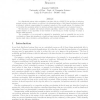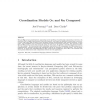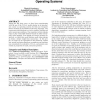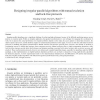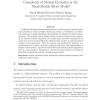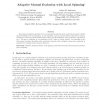290
click to vote
ACTA
2011
14 years 7 months ago
2011
A simple mutual exclusion algorithm is presented that only uses nonatomic shared variables of bounded size, and that satisfies bounded overtaking. When the shared variables behave...
123
Voted
FGCS
2010
14 years 11 months ago
2010
In a distributed system where scalability is an issue, like in a GRID [5], the problem of enforcing mutual exclusion often arises in a soft form: the infrequent failure of the mut...
114
Voted
ENTCS
2008
14 years 11 months ago
2008
Orc and Reo are two complementary approaches to the problem of coordinating components or services. On one hand, Orc is highly asynchronous, naturally dynamic, and based on epheme...
127
Voted
TPDS
2002
15 years 7 days ago
2002
Distributed dynamic channel allocation (DDCA) is a fundamental resource management problem in mobile cellular networks. It has a flavor of distributed mutual exclusion but is not e...
104
Voted
IPL
2000
15 years 12 days ago
2000
Abstract. The mutual exclusion protocol presented ensures that whatever perturbation the network undergo, it regains consistency in nite time: one and only one privilege token is p...
109
Voted
ENTCS
2002
15 years 12 days ago
2002
The perceived advantages of distributed systems, such as increased reliability and availability, are o set by the increased complexity of developing such applications. The develop...
125
Voted
SIGOPS
2008
15 years 16 days ago
2008
During the last three years, we have been experimenting with the use of the Uppaal model checker in an introductory course on operating systems for first-year Computer Science stu...
144
Voted
JPDC
2006
15 years 17 days ago
2006
Irregular parallel algorithms pose a significant challenge for achieving high performance because of the difficulty predicting memory access patterns or execution paths. Within an...
111
Voted
JPDC
2006
2006
A tight bound on remote reference time complexity of mutual exclusion in the read-modify-write model
15 years 17 days ago
In distributed shared memory multiprocessors, remote memory references generate processor-to-memory traffic, which may result in a bottleneck. It is therefore important to design ...
103
Voted
DC
2007
15 years 17 days ago
2007
We present an adaptive algorithm for N-process mutual exclusion under read/write atomicity in which all busy waiting is by local spinning. In our algorithm, each process p perform...

